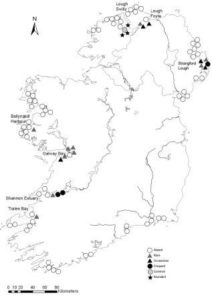Impacts of the spread of non-native oysters and interactions with native oysters
Non-native species constitute a serious problem for ecosystems, as there establishment can alter species composition, diversity and can out-compete native species. All this can have a negative impact on ecosystem functioning and alter services that are provided by these ecosystems, like oxygen generation, removal of CO2 from the atmosphere, water purification, etc. The spread of non-native marine species is enhanced globally by human activities such as transport and aquaculture. One such species distributed by these vectors is the Pacific oyster, Crassostrea gigas, which is native to Japan and has been introduced worldwide for aquaculture purposes.

For the first part of my project I looked at the spread of the Pacific oyster in Northern Ireland and revisited sites in the Republic of Ireland (where Pacific oysters have previously been found by Dr Judith Kochmann) to monitor their population (Figure 1). It is important to identify sites where environmental conditions promote the spread of the non-native oyster and being able to relate this information to other sites that could be at a potential risk of an invasion by the Pacific oyster. Most feral populations of the Pacific oyster were found in sheltered sea loughs, which usually feature a higher temperature than the surrounding sea. However when studying populations over time it was found that some populations have increased or kept stable, while others have decreased, due to reasons that are not always clear. Oyster mortality and age can then be correlated with environmental conditions with years that featured especially high mortalities or extremely successful spatfall, providing even more information about the invasion potential of the non-native oyster.

The second part of my project looks at differences in nutrient cycling between the native (Ostrea edulis) and non-native oyster. I would like to answer the question whether the non-native, Pacific oyster would provide the same ecosystem services as the native one, if the native oyster is to be out-competed. Therefore, I have set up an experiment in Lough Foyle (Republic of Ireland/Northern Ireland) (Figure 2), where densities (high, low) and assemblages of both oyster species (C. gigas, O. edulis) were manipulated on a tidal mud flat. Porewater and sediment samples will be taken every 2 months and the content of ammonium, iron, phosphate, silicate and total oxidised nitrogen in the porewater and the amount of organic matter as well as nitrogen and total organic carbon in the sediment will be quantified over 18 months. This experiment will allow us to gain a continuous dataset of nutrient cycling on a mudflat. It will also help to determine differences in nutrient cycling between species and whether nutrient cycling is promoted or inhibited by competition between these two species.
